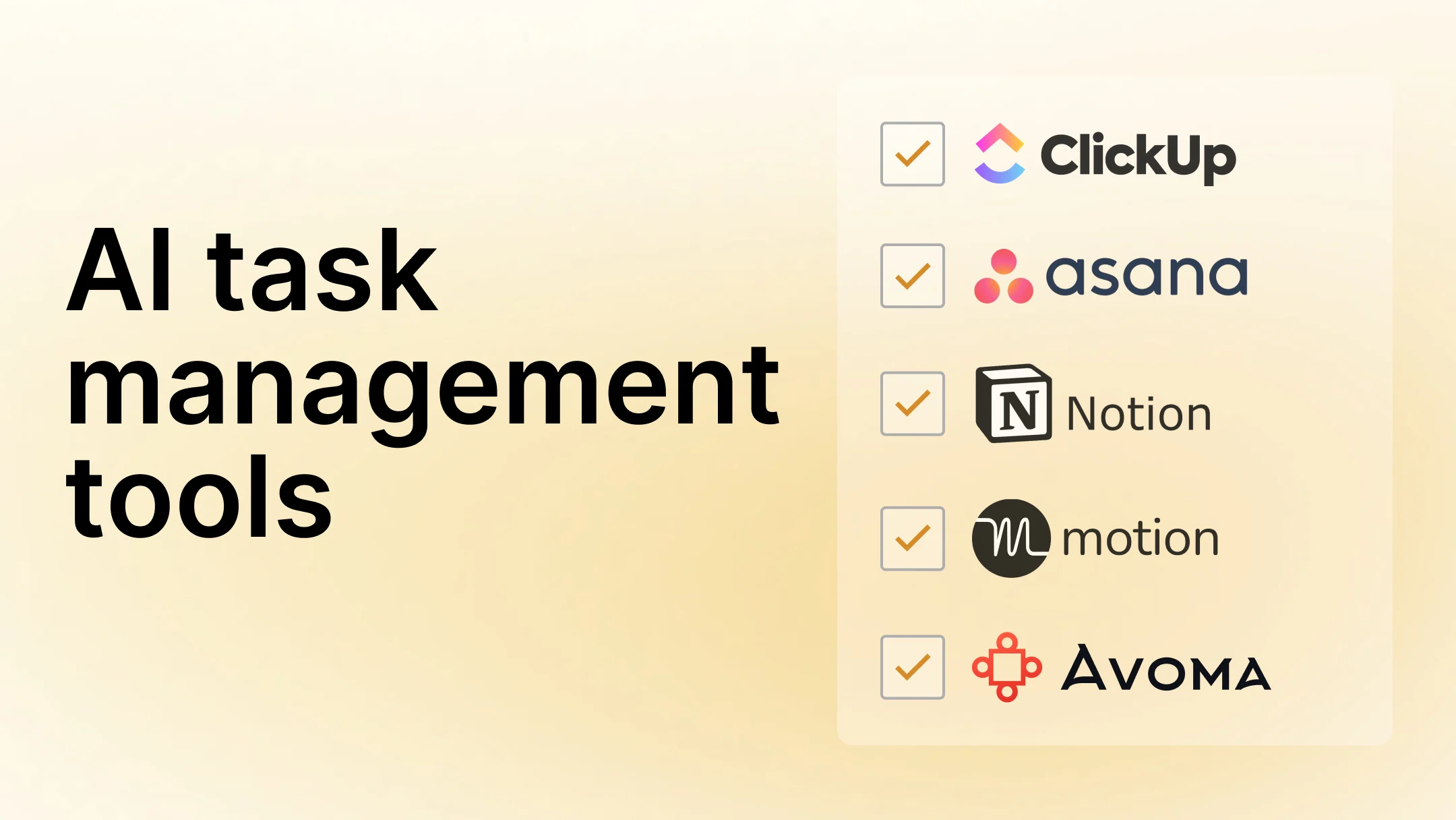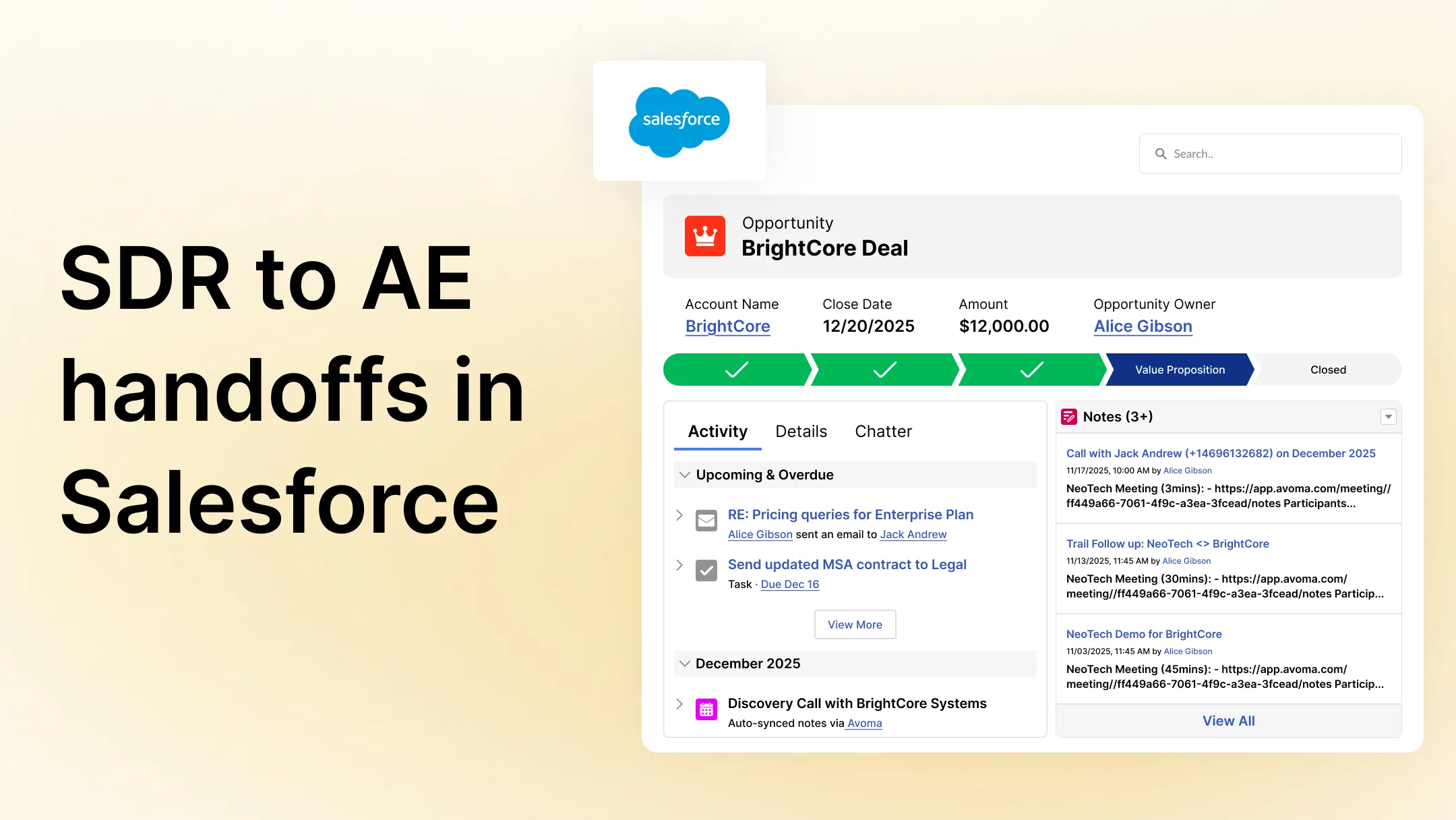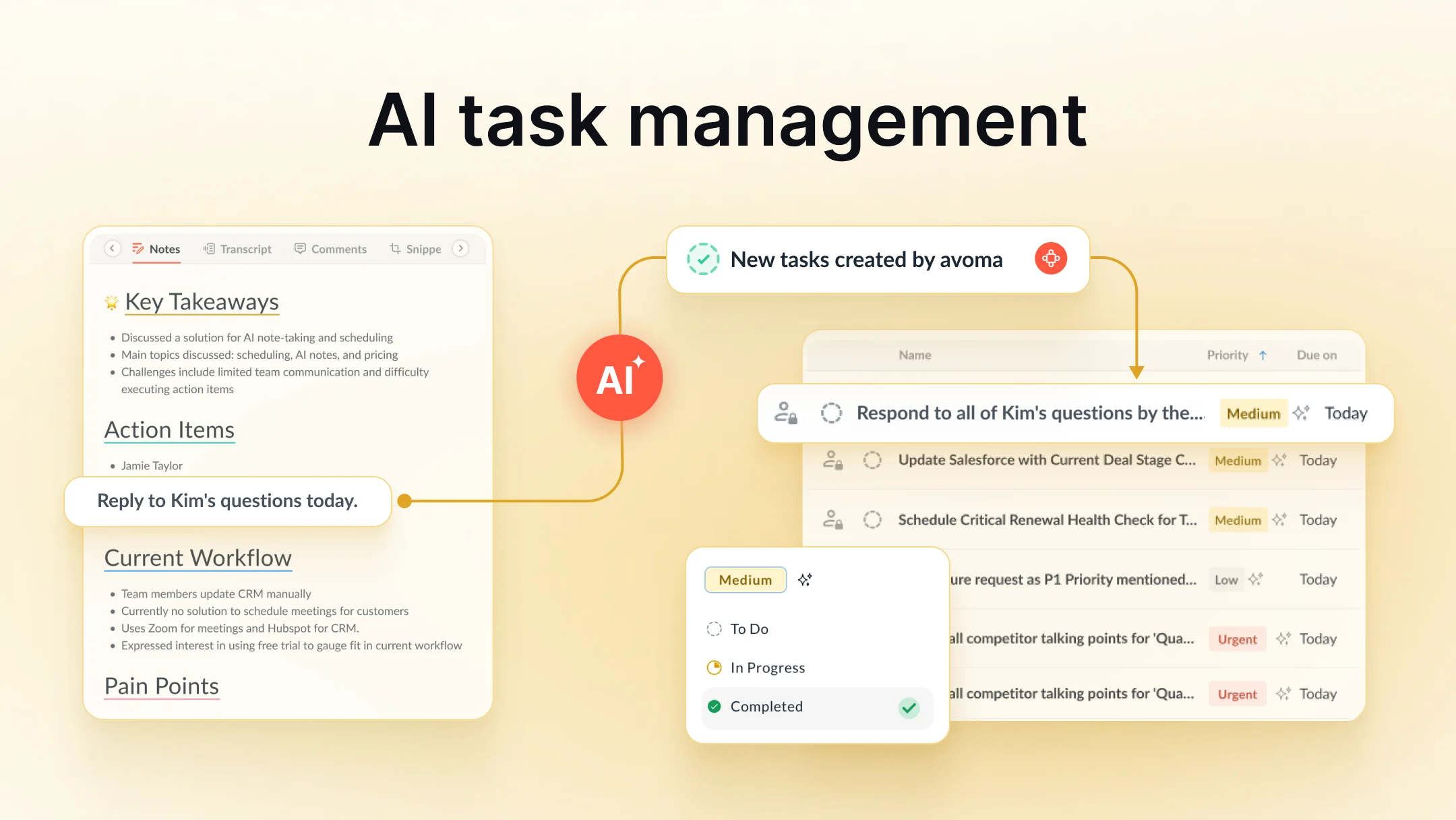A guide to understanding the Miller Heiman Sales Process
Table of Contents:

B2B enterprise sales are more complex than ever. Multiple decision-makers, longer sales cycles, and endless paperwork.
It’s critical for reps to identify key decision-makers and understand how they can influence their buying decision to close high-value deals faster.
The Miller Heiman sales process is a proven framework that enables sales teams to handle and close B2B enterprise deals. It empowers reps to create a strategic action plan, map out the customer buying process, and connect with the right individuals who have the power to move the deal forward.
In this blog post, we’ll look at the Miller Heiman process in detail, discuss how you can use this methodology for B2B enterprise sales, and explore the role of AI in making the implementation faster, simpler, and smarter. Let’s get started.
What is the Miller Heiman approach to selling?
The Miller Heiman sales process is a strategic framework designed for teams to manage complex B2B enterprise sales. It’s based on the principle of win-win outcomes for the buyer and seller, wherein the buyer shows how they can help prospects solve their problems and achieve maximum return on investment (ROI).
At its core, the sales methodology involves identifying key stakeholders, understanding their authority and degree of influence, and creating tailored sales strategies to address their needs and concerns.
A quick history of the Miller Heiman sales process
In 1978, Robert Miller and Stephen Heiman (from the Miller Heiman Group) published the book Strategic Selling, which quickly became a go-to for sales teams worldwide. It featured the legendary Blue Sheet, a core aspect of the Miller Heiman sales process, that helps sales teams align on the buyer’s objectives, pinpoint key stakeholders and decision-making process, identify red flags and strengths, and create customized sales strategies to help them achieve their goals.

Over time, the Miller Heiman sales process has evolved and updated to the Strategic Selling With Perspective, and is often used with other methodologies, such as Conceptual Selling and Large Account Management Process (which we will cover in detail below), depending on the client’s type and needs.
However, the basics of the methodology have remained the same: trust, relationship-building, and mutual benefit for both parties, i.e., the buyer and the seller.
How to use the Miller Heiman Sales Process: A step-by-step guide
As we saw, the Miller Heiman strategic selling process is designed for complex sales that involve large amounts of cash, multiple decision-makers, and a long sales cycle. Let’s go through each step of the Miller Heiman sales process in detail:
1. Identifying & categorizing buying influences
A HubSpot study reveals an average of five decision-makers involved in the sales process today. Enterprise sales are even more complex and complicated, with several stakeholders calling the shots, and it may not always be easy to uncover who is involved in the sales process.
For this reason, the Miller Heiman Strategic Selling Process categorizes four types of key stakeholders:
• Champions: This person is your internal advocate who supports your solution and helps to move the sales process forward.
• User buyer: These are team members who are the end users of your product.
• Technical buyer: Different departments, such as IT, engineering, and legal teams that determine if the solution meets the necessary technical requirements.
• Economic buyer: This person has the final decision-making power to approve or veto the deal.

During the discovery process, reps must ask open-ended questions to identify decision-makers and gauge the company’s typical buying process. Questions such as “Can you tell me more about who introduced you to our solution?” or “How will our solution fit into your everyday workflow, and who will use it the most?” will allow you to pinpoint the key influences faster and tailor strategies to each stakeholder's needs and requirements.
2. Understanding buyers’ motivation and attitude
Not every buyer will have the same attitude or motivation to buy your product. Some will be enthusiastic, while others will be skeptical and may need some convincing to get over the finish line.
The Miller Heiman sales process identifies four types of buyer attitudes (also known as buyer modes):
• Growth: Buyers in the Growth Mode want to change the status quo and are enthusiastic about discovering a new solution that can adapt and scale with their business. They’re interested in learning more about your product capabilities that can help them meet their business goals, such as improved revenue or team efficiency.
• Trouble: Buyers in the Trouble Mode are facing pressing challenges and need an immediate solution to help them get out of the fix.
• Even Keel: Buyers in this category are typically satisfied with their current solution and don’t see a need for a change. You need to show them the hidden growth possibilities to change their perspective and convince them to invest in your solution.
• Overconfident: These buyers are often very happy with the status quo and sometimes ignore the problems or overestimate the capabilities of their current solution. They’re resistant to change and much harder to persuade and sell to.
Understanding the spectrum on which your buyer falls will help you tailor your sales approach, confidently answer their questions, overcome objections, and establish trust and rapport for potential conversions.
3. Consider red flags, strengths, and competition
The Miller Heiman Sales Process asks reps to consider potential red flags associated with a deal to address and overcome any problems early on. For example, suppose you’re missing information on one of the key stakeholders. In that case, it’s an automatic red flag, and your chances of closing the deal would be less than deals with the complete buyer information.
Start by listing key stakeholders and their authority and influence on the purchase decision. Then, you can work towards identifying their unique challenges and pain points and customizing your approach to meet their needs.
You also need to consider your strengths and positioning compared to your competitors. As you go through sales discovery, note down the competitors and what prospects they like or dislike about them. This allows you to map your areas of differentiators and customize your sales script to perfectly resonate with your buyer’s pain points.
4. Influence the buyer’s decision for a win-win outcome
The final step in the Miller Heiman sales process is tailoring your pitch for each stakeholder to positively influence their buying decision.
For example, for an economic buyer, you may need to demonstrate how your solution can help them save costs and improve revenue. For a user buyer, their priority would be improving efficiency or a better UI/UX experience compared to a solution they're using.
The Miller Heiman sales process emphasizes on creating win results that demonstrate the value of your product and maximize their ROI. Here, you need to create win-results for each stakeholder, focusing on the specific outcomes they care about and how your solution fits in.
But remember, the goal again is not to make a quick sale and move on. It is to deliver value throughout the customer journey and prioritize long-lasting, sustainable relationships, so the customers keep coming back for more.
There you have it! The complete breakdown of the Miller Heiman Process.
Now, let's look at how you can use AI to automate nearly all aspects of the Miller Heiman sales process.
How AI can automate the Miller Heiman sales process
1. Automate account research
Before you hop on to a discovery call, it’s good to have some information about your prospect—their background, team size, and the industry they operate in, so you can establish a rapport from the get-go. AI can help you collect and enrich available data on prospects, such as demographics, company size, product offerings, funding status, and more, so you can prepare strategically for your sales call.
2. Extract insights related to key decision-makers
One of the main elements of the Miller Heiman Strategic Selling process is identifying and mapping key stakeholders who can influence the purchase decision.
AI-powered tools can record and analyze your sales call to extract insights on decision-makers, end users, champions, typical buying processes, potential blockers, and more.
It’s possible that reps may not uncover information related to all key stakeholders during the first discovery call. AI constantly analyzes your communication with prospects across emails, LinkedIn DMs, calls, and meetings, and automatically populates these details whenever they come to the fore. This enables you to tweak your strategy on the fly and tailor your messaging to stakeholder’s needs.
Another thing AI can do is generate automatic notes based on your conversation, outlining topics such as economic buyers, champions, timelines, decision-makers, and so on, so you can prepare for the next call or simply get context whenever you need.
Here’s how the notes populated by AI look like:

In Avoma, besides generating AI-powered notes, you can automatically draft email follow-ups, based on your last interaction with the prospect. Just hit ‘Send Follow-up’ on the top right corner of the screen, and Avoma will auto-generate an email, allowing you to share either a summary or notes with the meeting participants.

3. Capture buyers’ attitudes, objections, and potential red flags
Another thing the Miller Heiman Sales Process focuses on is gauging buyers’ attitudes and their motivation to purchase so you can determine your next move.
AI can help in a big way here. First off, it can analyze your sales calls for verbal and physical cues that can tell you what prospects liked and where they displayed hesitation or skepticism during the call. It can capture a sudden change in their body language, tone, or facial expressions that can help you determine the buyer's attitude or mindset to move forward with the conversation accordingly.
Sometimes, reps aren’t able to fully assess prospects' needs and catch potential red flags or buyer signals early in the process. AI-powered tools, such as Avoma, allow you to track specific keywords or phrases across conversations, such as those related to pricing or product capabilities, to uncover those hidden opportunities. In Avoma, even if a prospect doesn’t mention the exact term, such as pricing or discount, but mentions something like, “Is this the best you can do?” Avoma will understand and match the context with the keyword/concept you’re tracking.
These insights allow reps to understand more deeply which stage/mode buyers belong to, their inclination to purchase (are they window shopping or need an appropriate solution urgently), timelines, and any potential blockers, allowing you to craft a pitch as per the buyer's needs.
4. Bonus step: Integrate the Blue Sheet into the CRM
It’s one thing to extract insights using AI, but you don’t want to go back to the Blue Sheet to fill out this information manually.
A CRM can help you either completely replace the Blue Sheet or digitize and integrate it within the platform. It can capture, manage, and track all sales interactions in one place, enabling reps and managers to get an overview of the sales pipeline instantly.
Avoma can capture information related to the Miller Heiman sales process, such as key purchase influencers, buyer attitudes, objections, competitors, and red flags, and automatically sync these details to your preferred CRM (HubSpot, Salesforce, etc.). Any changes you make to the deal activity automatically get updated in the CRM, ensuring everyone has access to fresh, up-to-date information at all times. For custom fields, this sync works 2-way, so that information is updated in the CRM as well as Avoma.

Another integral part of the Miller Heiman sales process is creating a tailored action plan for each prospect based on their specific use case and requirements. A CRM allows you to document your sales strategy for each prospect in one place, make adjustments, drive collaborative input, and track and measure results over time.
5. Use AI-powered scorecards to track rep’s implementation & adherence to the methodology
The Blue Sheet implementation relies on sales reps conducting the discovery and then manually filling out the information. But the problem is: rep’s assessments are often subjective and based on their assumptions and personal biases. Managers also cannot get visibility into how reps are conducting the discovery, the questions they’re asking, and if they’re qualifying deals correctly.
This is where AI-powered scorecards come in. In scorecards, you can define questions related to the Miller Heiman sales process, and AI will automatically analyze the call and populate what was covered and what was missed. This allows you to gauge the areas reps covered, what they simply touched upon, and those questions they completely missed out on. Reps can also look at their score after each call to understand how they performed and if they adhered to the best practices.
In Avoma, you can set up custom scorecards related to the Miller Heiman Sales process, outlining questions on business goals, decision-makers, competitors, and more. Once the scorecard is ready and configured, Avoma will automatically score each call on a scale of 1 to 5, based on your defined rules. This allows you to assess the rep’s performance and adherence to the methodology, pinpoint areas of improvement, and customize sales coaching to help them improve.

Other core offerings of the Miller Heiman Sales Process
While the Blue Sheet is the most popular offering of the Miller Heiman sales process, the methodology also includes additional frameworks to help sales teams navigate complex B2B sales scenarios:
1. Conceptual Selling:
Conceptual Selling focuses on understanding buyer’s needs and challenges and tailoring your sales strategy based on that. It’s not only about highlighting your product features and benefits—but truly understanding your customer’s needs and delivering value to maintain a long-term relationship.
Why you should use it with the Blue Sheet:
The Blue Sheet’s core idea is also based on creating a win-win situation for buyers and sellers. Conceptual selling is a means to an end, encouraging reps to have deeper conversations with prospects to uncover their true needs and challenges. The focus is on presenting the solution in a way that resonates with the buyer’s needs, making it easy for them to see the value and invest in the solution.
2. Large account management process (LAMP):
The Large Account Management Process (LAMP) focuses on developing and maintaining relationships with strategic accounts. It uses the Gold Sheet to gather account data such as key players, revenue, pain points, industry trends, and more, and create a realistic account management plan that ensures success for the buyer and seller.
Why you should use it with the Blue Sheet:
While the Blue Sheet helps pin down key stakeholders for each account, the Large Account Management Process is geared toward creating a strategic action plan for each account. This involves setting goals, identifying key growth opportunities, and reviewing progress to tweak the strategy as needed.
Final thoughts
For complex B2B deals, where there are longer sales cycles, multiple touchpoints, and several decision-makers, the Miller Heiman sales process provides a strategic roadmap to meet each stakeholder’s needs and close high-value deals faster.
However, since this is a multi-layered and nuanced methodology, reps need extensive training on how to use and apply it in complex B2B sales scenarios. This is where AI-powered scorecards come in. It allows managers to set questions related to the Miller Heiman sales process, and AI automatically scores each call based on how well reps covered the questions and implemented the best practices. Managers can quickly look at rep’s performance and adherence, identify areas of improvement, and provide immediate feedback to hold reps accountable.
Want to see how you can implement the AI-powered custom scorecards? Talk to our product experts. Check out additional features of Avoma here.
Frequently Asked Questions






What's stopping you from turning every conversation into actionable insights?









